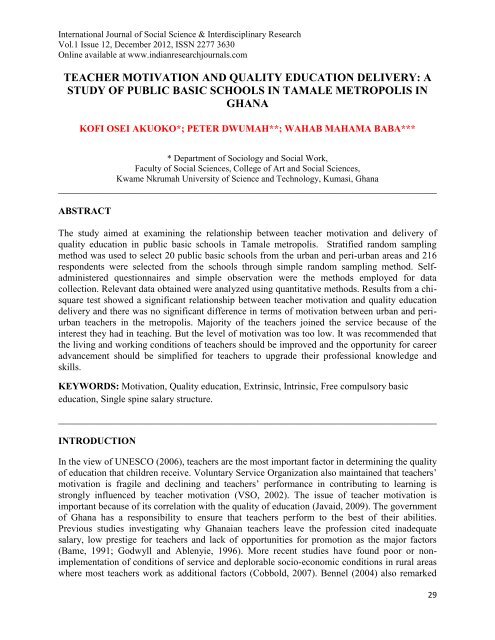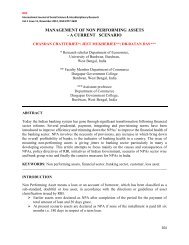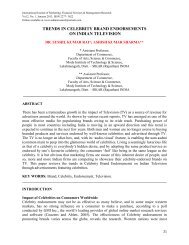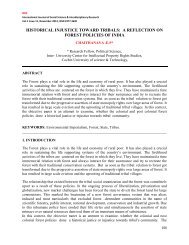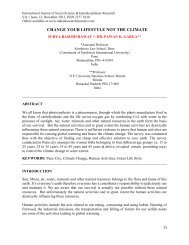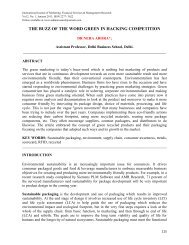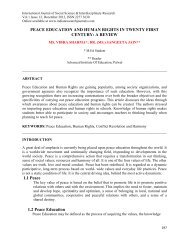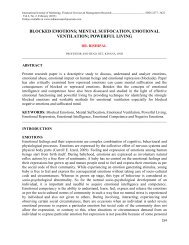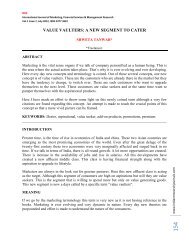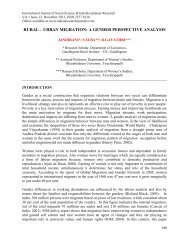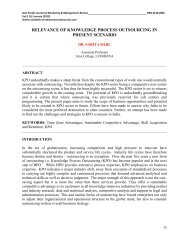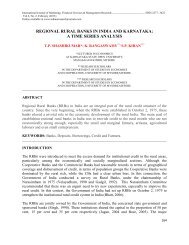teacher motivation and quality education delivery: a study of public ...
teacher motivation and quality education delivery: a study of public ...
teacher motivation and quality education delivery: a study of public ...
Create successful ePaper yourself
Turn your PDF publications into a flip-book with our unique Google optimized e-Paper software.
International Journal <strong>of</strong> Social Science & Interdisciplinary Research<br />
Vol.1 Issue 12, December 2012, ISSN 2277 3630<br />
Online available at www.indianresearchjournals.com<br />
TEACHER MOTIVATION AND QUALITY EDUCATION DELIVERY: A<br />
STUDY OF PUBLIC BASIC SCHOOLS IN TAMALE METROPOLIS IN<br />
GHANA<br />
KOFI OSEI AKUOKO*; PETER DWUMAH**; WAHAB MAHAMA BABA***<br />
* Department <strong>of</strong> Sociology <strong>and</strong> Social Work,<br />
Faculty <strong>of</strong> Social Sciences, College <strong>of</strong> Art <strong>and</strong> Social Sciences,<br />
Kwame Nkrumah University <strong>of</strong> Science <strong>and</strong> Technology, Kumasi, Ghana<br />
______________________________________________________________________________<br />
ABSTRACT<br />
The <strong>study</strong> aimed at examining the relationship between <strong>teacher</strong> <strong>motivation</strong> <strong>and</strong> <strong>delivery</strong> <strong>of</strong><br />
<strong>quality</strong> <strong>education</strong> in <strong>public</strong> basic schools in Tamale metropolis. Stratified r<strong>and</strong>om sampling<br />
method was used to select 20 <strong>public</strong> basic schools from the urban <strong>and</strong> peri-urban areas <strong>and</strong> 216<br />
respondents were selected from the schools through simple r<strong>and</strong>om sampling method. Selfadministered<br />
questionnaires <strong>and</strong> simple observation were the methods employed for data<br />
collection. Relevant data obtained were analyzed using quantitative methods. Results from a chisquare<br />
test showed a significant relationship between <strong>teacher</strong> <strong>motivation</strong> <strong>and</strong> <strong>quality</strong> <strong>education</strong><br />
<strong>delivery</strong> <strong>and</strong> there was no significant difference in terms <strong>of</strong> <strong>motivation</strong> between urban <strong>and</strong> periurban<br />
<strong>teacher</strong>s in the metropolis. Majority <strong>of</strong> the <strong>teacher</strong>s joined the service because <strong>of</strong> the<br />
interest they had in teaching. But the level <strong>of</strong> <strong>motivation</strong> was too low. It was recommended that<br />
the living <strong>and</strong> working conditions <strong>of</strong> <strong>teacher</strong>s should be improved <strong>and</strong> the opportunity for career<br />
advancement should be simplified for <strong>teacher</strong>s to upgrade their pr<strong>of</strong>essional knowledge <strong>and</strong><br />
skills.<br />
KEYWORDS: Motivation, Quality <strong>education</strong>, Extrinsic, Intrinsic, Free compulsory basic<br />
<strong>education</strong>, Single spine salary structure.<br />
______________________________________________________________________________<br />
INTRODUCTION<br />
In the view <strong>of</strong> UNESCO (2006), <strong>teacher</strong>s are the most important factor in determining the <strong>quality</strong><br />
<strong>of</strong> <strong>education</strong> that children receive. Voluntary Service Organization also maintained that <strong>teacher</strong>s‟<br />
<strong>motivation</strong> is fragile <strong>and</strong> declining <strong>and</strong> <strong>teacher</strong>s‟ performance in contributing to learning is<br />
strongly influenced by <strong>teacher</strong> <strong>motivation</strong> (VSO, 2002). The issue <strong>of</strong> <strong>teacher</strong> <strong>motivation</strong> is<br />
important because <strong>of</strong> its correlation with the <strong>quality</strong> <strong>of</strong> <strong>education</strong> (Javaid, 2009). The government<br />
<strong>of</strong> Ghana has a responsibility to ensure that <strong>teacher</strong>s perform to the best <strong>of</strong> their abilities.<br />
Previous studies investigating why Ghanaian <strong>teacher</strong>s leave the pr<strong>of</strong>ession cited inadequate<br />
salary, low prestige for <strong>teacher</strong>s <strong>and</strong> lack <strong>of</strong> opportunities for promotion as the major factors<br />
(Bame, 1991; Godwyll <strong>and</strong> Ablenyie, 1996). More recent studies have found poor or nonimplementation<br />
<strong>of</strong> conditions <strong>of</strong> service <strong>and</strong> deplorable socio-economic conditions in rural areas<br />
where most <strong>teacher</strong>s work as additional factors (Cobbold, 2007). Bennel (2004) also remarked<br />
29
International Journal <strong>of</strong> Social Science & Interdisciplinary Research<br />
Vol.1 Issue 12, December 2012, ISSN 2277 3630<br />
Online available at www.indianresearchjournals.com<br />
H a : Teachers in peri-urban schools are not better motivated than their urban counterparts.<br />
CONCEPTUAL FRAMEWORK<br />
Teacher <strong>motivation</strong> affects <strong>quality</strong> <strong>education</strong> <strong>delivery</strong>. Both extrinsic factors (including salary<br />
<strong>and</strong> allowances, pr<strong>of</strong>essional advancement, promotion, award schemes) <strong>and</strong> intrinsic factors<br />
(such as ability <strong>and</strong> competence, consultation, achievements, recognition <strong>and</strong> good interpersonal<br />
relationship) impact on <strong>teacher</strong> <strong>motivation</strong>. Other school factors such as teaching <strong>and</strong> learning<br />
materials (TLM), supervision, attitudes <strong>of</strong> parents, school management committees (SMC),<br />
Parents-Teachers Association (PTA) as well as school environment among others affect <strong>teacher</strong><br />
<strong>motivation</strong>. Teacher <strong>motivation</strong> in turn impacts on their performance in terms <strong>of</strong> attendance,<br />
contact hours <strong>and</strong> lesson <strong>delivery</strong>. This ultimately affects <strong>quality</strong> <strong>education</strong> <strong>delivery</strong> manifested<br />
in the Basic Education Certificate Examination (BECE) results, Pupil-Teacher Ratio (PTR),<br />
Number <strong>of</strong> Qualified Teachers (NQT), Pupil Core Text Book Ratio (PCTBR), Pupil-Desk Ratio<br />
(PDR) <strong>and</strong> class size.<br />
LITERATURE REVIEW<br />
The concept „<strong>motivation</strong>‟ is concerned with the factors that influence people to behave in certain<br />
ways. Motivating other people is about getting them to move in the direction one wants them to<br />
go in order to achieve a result. Motivation can be described as goal-directed behaviour. People<br />
are motivated when they expect that a course <strong>of</strong> action is likely to lead to the attainment <strong>of</strong> a goal<br />
<strong>and</strong> a valued reward - one that satisfies their needs (Armstrong, 2007; Hoy <strong>and</strong> Miskel, 1991;<br />
Tracy (2000) as cited in Ofoegbu (2004). Motivation is thought to be responsible for "why<br />
people decide to do something, how long they are willing to sustain the activity <strong>and</strong> how hard<br />
they are going to pursue it" (Dörnyei, 2001).<br />
There are two types <strong>of</strong> <strong>motivation</strong> as originally identified by Herzberg, Mausner <strong>and</strong> Snyderman<br />
(1957). Intrinsic <strong>motivation</strong> is self-generated factors that influence people to behave in a<br />
particular way or to move in a particular direction. These factors include responsibility (feeling<br />
that the work is important <strong>and</strong> having control over one‟s own resources), autonomy (freedom to<br />
act), scope to use <strong>and</strong> develop skills <strong>and</strong> abilities, interesting <strong>and</strong> challenging work <strong>and</strong><br />
opportunities for advancement (Armstrong, 2007). Extrinsic <strong>motivation</strong> relates to what is done to<br />
or for people to motivate them. These include rewards such as increased pay, praise, or<br />
promotion, <strong>and</strong> punishments, such as disciplinary action, withholding pay or criticism,<br />
(Armstrong, 2007). It is also influenced by external factors such as salary, providing better<br />
working <strong>and</strong> living conditions <strong>and</strong> opportunities for in-service training.<br />
There are several theories <strong>of</strong> <strong>motivation</strong> which can be applied to studies on <strong>teacher</strong> <strong>motivation</strong>.<br />
Content theory assumes that all individuals possess the same set <strong>of</strong> needs <strong>and</strong> therefore<br />
prescribe the characteristics that ought to be present in jobs. In other words, it states that<br />
<strong>motivation</strong> is essentially about taking action to satisfy needs, <strong>and</strong> identifies the main needs that<br />
influence behaviour (Armstrong, 2007). Need theory was originated by Maslow (1954), <strong>and</strong> in<br />
their two-factor model, Herzberg, Mausner <strong>and</strong> Snyderman (1957) listed needs which they<br />
termed „satisfiers‟. Process theory focuses on psychological processes which affect<br />
<strong>motivation</strong>, by reference to expectations (Vroom, 1964 cited in Bennell <strong>and</strong> Akyeampong, 2007),<br />
goals (Latham <strong>and</strong> Locke, 1979 in Huczynski <strong>and</strong> Buchanan, 2001) <strong>and</strong> perception <strong>of</strong> equity.<br />
31
International Journal <strong>of</strong> Social Science & Interdisciplinary Research<br />
Vol.1 Issue 12, December 2012, ISSN 2277 3630<br />
Online available at www.indianresearchjournals.com<br />
Johnson Three-Model theory combined expectancy theory, equity theory <strong>and</strong> Job enrichment<br />
theory. Process theories stress the difference in people‟s needs <strong>and</strong> focus on the cognitive<br />
processes that create these differences.<br />
Teacher <strong>motivation</strong> has to do with <strong>teacher</strong>s' attitude to work. Teacher <strong>motivation</strong> could therefore<br />
be referred to as those factors that operate within the school system which if not made available<br />
to the <strong>teacher</strong> could hamper performance, cause stress, discontentment <strong>and</strong> frustration all <strong>of</strong><br />
which would subsequently reduce classroom effectiveness <strong>and</strong> student <strong>quality</strong> output. This<br />
implies that <strong>teacher</strong> <strong>motivation</strong> includes factors that cause, channel, sustain <strong>and</strong> influence<br />
<strong>teacher</strong>s' behaviour towards high management <strong>and</strong> academic achievement st<strong>and</strong>ards in schools<br />
(Ofoegbu, 2004). According to Dörnyei (2001) the following factors affect <strong>teacher</strong> <strong>motivation</strong>:<br />
the school‟s general climate <strong>and</strong> the existing school norms, the class sizes, the school resources<br />
<strong>and</strong> facilities, general expectations regarding student potential, the school‟s leadership <strong>and</strong><br />
decision-making structure. Restricted autonomy is believed to be one <strong>of</strong> the negative influences<br />
on <strong>teacher</strong> <strong>motivation</strong>.<br />
The findings <strong>of</strong> EFA report <strong>of</strong> 2005 revealed that <strong>teacher</strong>s in developing countries <strong>of</strong>ten receive<br />
earnings that are insufficient at providing them with a reasonable st<strong>and</strong>ard <strong>of</strong> living. Bennel<br />
(2004) also remarked that <strong>teacher</strong>s‟ pay <strong>and</strong> other material benefits were too low for individual<br />
<strong>and</strong> household survival needs to be met in developing countries. Indeed, careful analyses <strong>of</strong> the<br />
literature seem to suggest that salary is crucial in <strong>teacher</strong> satisfaction among the developing<br />
countries. This is so because a <strong>study</strong> conducted by Tasnim (2006) found Bangladeshi <strong>teacher</strong>s to<br />
be dissatisfied with their salary levels. Also, Zembylas <strong>and</strong> Papanastasious (2004) in their <strong>study</strong><br />
<strong>of</strong> Cyprus <strong>teacher</strong>s found that salary was one <strong>of</strong> the issues which dissatisfied <strong>teacher</strong>s. These<br />
findings point to the fact that the issue <strong>of</strong> <strong>teacher</strong>s‟ salary must be taken seriously. Akinwumi<br />
(2000) cited in Adelabu (2005) found that what the typical low-income earning <strong>teacher</strong> yearns is<br />
a sizeable salary increase, <strong>and</strong> they conclude that the payment <strong>of</strong> a living wage would<br />
significantly enhance their commitment <strong>and</strong> performance.<br />
The work environment is another important determining factor in <strong>teacher</strong> <strong>motivation</strong>. The<br />
<strong>teacher</strong>‟s working environment in Nigeria has been described as the most impoverished <strong>of</strong> all<br />
sectors <strong>of</strong> the labour force (NPEC, Nigeria 1998 cited in Adelabu, 2005). Facilities in most<br />
schools are dilapidated <strong>and</strong> inadequate as noted by Adelabu (2005) <strong>and</strong> Sanusi (1998) cited in<br />
Adelabu (2005). In comparison <strong>of</strong> <strong>teacher</strong>s in private <strong>and</strong> <strong>public</strong> schools, Kazeem (1999) <strong>and</strong><br />
Akinwumi (2000), both cited in Adelabu (2005) found that private school <strong>teacher</strong>s appear more<br />
motivated than <strong>teacher</strong>s in <strong>public</strong> schools. Regular payment <strong>of</strong> salaries <strong>and</strong> much lower pupil<strong>teacher</strong><br />
ratios are key reasons for this.<br />
The definition <strong>of</strong> <strong>quality</strong> <strong>education</strong> becomes more problematic when <strong>quality</strong> is conceptualized in<br />
terms <strong>of</strong> a particular aspect <strong>of</strong> <strong>education</strong> because as Dare (2005) cited in Ankomah, Koomson,<br />
Bosu <strong>and</strong> Oduro (2005) observes, „all the elements associated with <strong>education</strong>al <strong>quality</strong> are<br />
interrelated. Moreover, questions regarding <strong>quality</strong> <strong>education</strong> generally may encompass<br />
important aspect <strong>of</strong> the <strong>education</strong>al system such as infrastructure, school buildings,<br />
administration, leadership, management, <strong>teacher</strong> training, <strong>education</strong>al materials, teaching, <strong>and</strong><br />
student achievement (USAID, 2009). Therefore, in defining <strong>quality</strong> <strong>of</strong> <strong>education</strong>, outcomes or<br />
results should not be the only focus for <strong>quality</strong> because the purpose <strong>of</strong> <strong>education</strong> is wide <strong>and</strong><br />
varied based on the individual country (USAID, 2009). This complex situation makes even<br />
agreement on <strong>quality</strong> assessment results problematic.<br />
32
International Journal <strong>of</strong> Social Science & Interdisciplinary Research<br />
Vol.1 Issue 12, December 2012, ISSN 2277 3630<br />
Online available at www.indianresearchjournals.com<br />
UNESCO as cited in Education for All (EFA) (2005) identified social change, the notion <strong>of</strong> lifelong<br />
learning, relevance, <strong>and</strong> emphasis on science <strong>and</strong> technology as factors to improve the<br />
<strong>quality</strong> <strong>of</strong> <strong>education</strong>. UNICEF emphasizes five desirable dimensions <strong>of</strong> <strong>quality</strong> <strong>education</strong>:<br />
“learners, environment, content, processes, <strong>and</strong> outcomes that are founded on the rights <strong>of</strong> the<br />
whole child <strong>and</strong> all children to survival, protection, development, <strong>and</strong> participation (UNICEF,<br />
2000 cited in Ankomah et al (2005)”. In 1990 the World Declaration on Education for All<br />
(EFA), identified <strong>quality</strong> as a prerequisite for achieving the fundamental goal <strong>of</strong> equity. While<br />
the notion <strong>of</strong> <strong>quality</strong> was not fully developed, it was recognized that exp<strong>and</strong>ing access alone<br />
would be insufficient for <strong>education</strong> to contribute fully to the development <strong>of</strong> the individual <strong>and</strong><br />
society. Emphasis was accordingly placed on assuring an increase in children‟s cognitive<br />
development by improving the <strong>quality</strong> <strong>of</strong> their <strong>education</strong>. The conference recommended that the<br />
cognitive development <strong>of</strong> children should be emphasized as an indicator <strong>of</strong> <strong>quality</strong> <strong>education</strong>.<br />
The Millennium Conference (the 2000 Dakar Framework for Action) exp<strong>and</strong>ed the definition <strong>of</strong><br />
<strong>quality</strong> to include the desirable characteristics <strong>of</strong> learners (healthy, motivated students),<br />
processes (competent <strong>teacher</strong>s using active pedagogies), content (relevant curricula) <strong>and</strong> systems<br />
(good governance <strong>and</strong> equitable resource allocation). (Dakar Framework for Action, 2000 cited<br />
in Ankomah et al, 2005).<br />
Etsey (2004) cited in Ankomah et al (2005) showed that the <strong>quality</strong> <strong>of</strong> basic <strong>education</strong> is low in<br />
Ghana despite funding by international donors <strong>and</strong> different interventions to improve the <strong>quality</strong><br />
<strong>of</strong> basic <strong>public</strong> <strong>education</strong>. According to Kraft (1995) cited in Ankomah et al (2005) there is a<br />
dramatic difference between the <strong>education</strong>al opportunities available to children in rural settings<br />
<strong>and</strong> those who attend school in towns, regional centers <strong>and</strong> the national capital. Also, there is<br />
overwhelming geographical disparity between the southern, central, <strong>and</strong> northern zones <strong>of</strong> Ghana<br />
in every aspect <strong>of</strong> schooling. A <strong>study</strong> <strong>of</strong> private schools in Ghana by the Educational Assessment<br />
<strong>and</strong> Research Centre (EARC) (2002) shows that parents enroll their children in private schools<br />
because they believe the schools <strong>of</strong>fer a better <strong>quality</strong> <strong>education</strong> <strong>and</strong> their performance was<br />
higher than <strong>public</strong> schools. The difference was attributed to the <strong>quality</strong> <strong>of</strong> supervision <strong>of</strong><br />
instruction in private schools. Opare (1999) cited in Ankomah et al (2005) also observed that<br />
„monitoring <strong>and</strong> supervision <strong>of</strong> <strong>teacher</strong>‟s work was more regular in private schools than in <strong>public</strong><br />
junior secondary schools in Accra <strong>and</strong> Sekondi-Takoradi. A <strong>study</strong> by Owusu-Ansah (2005) on<br />
time management in schools reported in Ankomah et al (2005) also found that „while both<br />
private <strong>and</strong> <strong>public</strong> schools misused instructional time, the private schools better managed<br />
instructional time than the <strong>public</strong> schools‟. Generally, what is common to all the studies is that<br />
the <strong>quality</strong> <strong>of</strong> <strong>education</strong> is low. It is lower in rural schools than in urban ones, <strong>and</strong> lower in <strong>public</strong><br />
schools than in private schools.<br />
RESEARCH METHODS<br />
Research Setting: Tamale Metropolis is the capital <strong>of</strong> the Northern Region <strong>of</strong> Ghana. The<br />
Tamale Metropolitan Assembly (TAMA) is one <strong>of</strong> the 20 districts <strong>and</strong> the only Metropolitan<br />
Assembly in the Northern region. The Metropolis has a total estimated l<strong>and</strong> size <strong>of</strong> 750 km sq<br />
which is about 13% <strong>of</strong> the total l<strong>and</strong> area <strong>of</strong> the Northern Region. There are a total <strong>of</strong> 197<br />
communities in the Metropolis <strong>of</strong> which 33 are urban communities. In 1984, the population <strong>of</strong><br />
the Metropolis was 167,778 inhabitants which rose up to 293,881 in 2000 (GLSS, 2000). The<br />
development <strong>of</strong> <strong>education</strong> in the area dated as far back as 1940s when a local primary was<br />
33
International Journal <strong>of</strong> Social Science & Interdisciplinary Research<br />
Vol.1 Issue 12, December 2012, ISSN 2277 3630<br />
Online available at www.indianresearchjournals.com<br />
established <strong>and</strong> since then <strong>education</strong> received a tremendous boost. Currently, the metropolis has<br />
a university campus. Apart from this, Tamale has a Polytechnic, two Teacher Training Colleges,<br />
Nursing Training College, <strong>and</strong> Community Health Training School, <strong>and</strong> School <strong>of</strong> Hygiene.<br />
Also, there are eleven (11) <strong>public</strong> senior high schools <strong>and</strong> seven (7) private Senior High Schools.<br />
In addition, there are two hundred <strong>and</strong> twenty eight (228) kindergartens (KGs), two hundred <strong>and</strong><br />
fifty seven (257) primary schools <strong>and</strong> one hundred <strong>and</strong> three (103) junior high schools (JHS).<br />
Apart from this, there are a total <strong>of</strong> one hundred <strong>and</strong> sixty seven (167) registered private basic<br />
schools in Tamale Metropolitan area (Tamale Metropolitan Education Office).<br />
Research Design: This <strong>study</strong> was a social survey, cross-sectional in approach <strong>and</strong> explanatory in<br />
content. It aimed at finding out about the state <strong>of</strong> <strong>teacher</strong>s <strong>motivation</strong> in Tamale metropolis <strong>and</strong><br />
to explain the relationship between <strong>teacher</strong> <strong>motivation</strong> <strong>and</strong> <strong>quality</strong> <strong>education</strong> <strong>delivery</strong>.<br />
Sampling Procedure<br />
Target Population: All the <strong>teacher</strong>s in the <strong>public</strong> basic schools, both primary <strong>and</strong> JHS, located<br />
in the Tamale Metropolitan Area were targeted for the <strong>study</strong>.<br />
Study Population: The <strong>study</strong> focused on only the <strong>teacher</strong>s <strong>and</strong> head <strong>teacher</strong>s from the selected<br />
basic schools in the metropolis. The <strong>study</strong> population was obtained from the schools selected for<br />
the <strong>study</strong>.<br />
Unit <strong>of</strong> Analysis: The individual <strong>teacher</strong>s <strong>and</strong> head<strong>teacher</strong>s constituted the sampling units for<br />
this <strong>study</strong>. In this <strong>study</strong> therefore, the <strong>teacher</strong>s‟ opinions <strong>and</strong> characteristics were sought to <strong>study</strong><br />
the <strong>motivation</strong>al levels <strong>of</strong> <strong>teacher</strong>s <strong>and</strong> its effect on <strong>quality</strong> <strong>education</strong> <strong>delivery</strong> in <strong>public</strong> basic<br />
schools in the Tamale metropolis <strong>of</strong> Ghana.<br />
Sampling frame: The list <strong>of</strong> all <strong>public</strong> basic schools <strong>and</strong> their <strong>teacher</strong>s constituted the sampling<br />
frame for the <strong>study</strong>. The list <strong>of</strong> schools was obtained from the Metropolitan Education Office in<br />
Tamale. Also, the list <strong>of</strong> <strong>teacher</strong>s was obtained from the various selected <strong>public</strong> basic schools.<br />
The sampling frame helped the researcher to choose a sample that was representative <strong>of</strong> the<br />
population being studied.<br />
Sample Selection <strong>and</strong> Sample Size: Stratified r<strong>and</strong>om sampling technique was used to select 20<br />
<strong>public</strong> basic schools with both primary schools <strong>and</strong> JHS from urban <strong>and</strong> peri-urban areas.<br />
Stratified sampling was used to ensure that the data was fairly representative <strong>of</strong> the views <strong>of</strong> the<br />
population. The total number <strong>of</strong> <strong>teacher</strong>s from the selected 20 <strong>public</strong> basic schools was 300.<br />
From tabulated values <strong>of</strong> different sample sizes, a population <strong>of</strong> 300 individuals requires a<br />
minimum sample size <strong>of</strong> 168 for a 95% confidence level at 5% margin <strong>of</strong> error (Saunders, Lewis<br />
<strong>and</strong> Thornhill, 2009). Therefore, a simple r<strong>and</strong>om sampling technique was used to select 216<br />
respondents for the <strong>study</strong>. This consisted <strong>of</strong> 191 <strong>teacher</strong>s <strong>and</strong> 25 head <strong>teacher</strong>s.<br />
Methods for Collecting Primary Data: Primary data was collected using self-administered<br />
questionnaire. Another data collection method adopted in this <strong>study</strong> was simple observation. The<br />
researchers observed the activities taking place within the physical environment with regard to<br />
teaching, learning, the interaction between <strong>teacher</strong>s <strong>and</strong> pupils, <strong>and</strong> the availability <strong>of</strong> both<br />
teaching <strong>and</strong> learning materials <strong>and</strong> visiting <strong>of</strong> libraries.<br />
Piloting <strong>of</strong> the questionnaire: A pilot <strong>study</strong> <strong>of</strong> the questionnaire was undertaken using twenty<br />
five (25) <strong>teacher</strong>s <strong>and</strong> five (5) head <strong>teacher</strong>s from five <strong>public</strong> basic schools in Savelugu/Nanton<br />
District to ascertain whether the concepts used would be well understood by respondents <strong>and</strong> the<br />
time taken to complete the questionnaire which ranged from 20 to 30 minutes was adequate.<br />
34
International Journal <strong>of</strong> Social Science & Interdisciplinary Research<br />
Vol.1 Issue 12, December 2012, ISSN 2277 3630<br />
Online available at www.indianresearchjournals.com<br />
Field Problems: The major problem was the sit down strike <strong>and</strong> a series <strong>of</strong> demonstrations by<br />
<strong>teacher</strong>s all over Ghana as a result <strong>of</strong> the migration <strong>of</strong> their salaries to the Single Spine Salary<br />
Structure (SSSS). The basic schools vacation period was another limiting factor. The researchers<br />
had to wait for schools to resume before they could continue to solicit information for the <strong>study</strong>.<br />
Reluctance <strong>of</strong> some <strong>teacher</strong>s to provide information especially as a result <strong>of</strong> their dissatisfaction<br />
about SSSS implementation was another problem that could not be understated. To ensure higher<br />
response rate the researchers made their objectives <strong>of</strong> the <strong>study</strong> known to the <strong>teacher</strong>s <strong>and</strong> further<br />
assured them <strong>of</strong> confidentiality.<br />
Data Management: After administering the instrument, the data collected were coded, edited,<br />
cleaned <strong>and</strong> entered into the computer for further analysis. For <strong>quality</strong> control, data was checked<br />
in the field to ensure that the information collected was accurately recorded.<br />
Ethical Issues: There were a number <strong>of</strong> ethical considerations made during the <strong>study</strong>. Voluntary<br />
participation was encouraged. Responding to interviews <strong>and</strong> filling <strong>of</strong> questionnaires required<br />
significant time <strong>and</strong> energy <strong>and</strong> its participation could disrupt the respondents‟ regular activity.<br />
For this reason, the researchers explained the objectives <strong>and</strong> significance <strong>of</strong> the <strong>study</strong> to the<br />
respondents <strong>and</strong> allowed them to exercise their right to voluntary participation. Respondents<br />
could be harmed psychologically by questions bordering on their living <strong>and</strong> working conditions,<br />
attendance <strong>and</strong> punctuality to school, salary satisfaction <strong>and</strong> receipt <strong>of</strong> allowances. To avoid the<br />
psychological harm, questions were framed in a manner that was not <strong>of</strong>fensive. They were<br />
assured that the information they provided would be kept confidential. To ensure this, the<br />
researchers removed information that required identification <strong>of</strong> names <strong>of</strong> respondents <strong>and</strong><br />
schools, <strong>and</strong> replaced them with identification letters <strong>and</strong> numbers so that a follow-up could be<br />
made for clarification purposes if there was a need.<br />
ANALYSIS AND INTERPRETATION OF DATA<br />
Socio-Demographic Characteristics <strong>of</strong> Respondents<br />
Age <strong>of</strong> Respondents: Age is an essential factor in determining labour force participation in work<br />
organization. The data revealed that 42.6% <strong>of</strong> respondents were within the ages <strong>of</strong> 30-39, 29.2%<br />
fell between 20-29 years, 19.4% <strong>of</strong> the respondents fell between the ages <strong>of</strong> 40-49 <strong>and</strong> 8.3<br />
percent were those who were above 50 years with only one respondent (0.5%) under 20 years. It<br />
was revealed that majority <strong>of</strong> the respondents were in their youthful age <strong>and</strong> could work for<br />
longer years in the service.<br />
Sex: It was revealed that an overwhelming majority (65.7%) <strong>of</strong> respondents were male <strong>teacher</strong>s<br />
while 34.3% were female <strong>teacher</strong>s. This reflected the male dominance in Ghanaian formal sector<br />
employment.<br />
Marital Status: The data showed that majority <strong>of</strong> the respondents (63%) were married <strong>and</strong><br />
27.3% were single <strong>and</strong> had never married. 9.7% were divorced or widowed or separated.<br />
Educational background: The <strong>education</strong>al background <strong>of</strong> respondents was important since the<br />
core responsibility <strong>of</strong> <strong>teacher</strong>s was imparting knowledge <strong>and</strong> skills to pupils in the country. The<br />
data indicated that 48.6% had university <strong>education</strong> <strong>and</strong> 42.6% had <strong>teacher</strong>s‟ certificate „A‟. Only<br />
6.5% <strong>of</strong> the respondents completed vocational/technical schools <strong>and</strong> 1.85% had secondary<br />
school certificates <strong>and</strong> only one person had finished a commercial school. The <strong>study</strong> revealed<br />
that majority (90.7%) <strong>of</strong> <strong>public</strong> basic school <strong>teacher</strong>s in Tamale Metropolis were pr<strong>of</strong>essionally<br />
trained, whereas 9.3% were not pr<strong>of</strong>essionally trained.<br />
35
International Journal <strong>of</strong> Social Science & Interdisciplinary Research<br />
Vol.1 Issue 12, December 2012, ISSN 2277 3630<br />
Online available at www.indianresearchjournals.com<br />
Decision to become a <strong>teacher</strong>: In response to a question as to why respondents decided to<br />
become <strong>teacher</strong>s, 58.7% <strong>of</strong> the pr<strong>of</strong>essional <strong>teacher</strong>s said they were interested in teaching.<br />
Majority (55%) <strong>of</strong> the unpr<strong>of</strong>essional <strong>teacher</strong>s gave the same reason. Also, 20.4% <strong>of</strong> the<br />
pr<strong>of</strong>essional <strong>teacher</strong>s stated lack <strong>of</strong> employment opportunities as the reason why they decided to<br />
join teaching pr<strong>of</strong>ession <strong>and</strong> 40% <strong>of</strong> the unpr<strong>of</strong>essional <strong>teacher</strong>s stated the same reason. In<br />
relation to pay, only 7.7% <strong>of</strong> the pr<strong>of</strong>essional <strong>teacher</strong>s stated pay as the reason why they chose<br />
teaching as their pr<strong>of</strong>ession. With working hours <strong>and</strong> school holidays, 9.7% <strong>of</strong> the pr<strong>of</strong>essional<br />
<strong>teacher</strong>s said they decided to join the pr<strong>of</strong>ession because <strong>of</strong> the working hours <strong>and</strong> holidays<br />
enjoyed by <strong>teacher</strong>s. Interestingly, 3.6% <strong>of</strong> the pr<strong>of</strong>essional <strong>teacher</strong>s gave other reasons such as<br />
„„a stepping stone‟‟, „„lack <strong>of</strong> financial support to further their <strong>education</strong> at the university‟‟ <strong>and</strong><br />
„„they followed their parents‟ advice‟‟.<br />
The best incentive that motivates <strong>teacher</strong>s: In an answer to a question about the best<br />
incentives that could motivate <strong>teacher</strong>s to be committed to their work the data indicated that 24%<br />
<strong>of</strong> respondents from both urban <strong>and</strong> peri-urban schools said improvement <strong>of</strong> salary <strong>and</strong><br />
allowances could motivate them to work hard. Also, 22.2% <strong>of</strong> the respondents indicated that the<br />
best motivating factor was conducive environment whilst 14.8% considered regular promotion as<br />
best <strong>motivation</strong>al factor for them. Some respondents (8.3%) viewed award schemes as the best<br />
form <strong>of</strong> <strong>motivation</strong>. Also, whilst 7.9% <strong>of</strong> respondents considered participation in decision<br />
making as the best <strong>motivation</strong> factor, another 7.9% were <strong>of</strong> the opinion that they were motivated<br />
by recognition <strong>and</strong> respect they received from the people. Surprisingly, only 5.6% <strong>and</strong> 6.0%<br />
chose pupils‟ academic performance <strong>and</strong> <strong>teacher</strong>s‟ competence respectively as best factors <strong>of</strong><br />
<strong>motivation</strong>. This revelation clearly indicated that academic performance <strong>of</strong> pupils was not the<br />
priority <strong>of</strong> the <strong>teacher</strong>s interviewed.<br />
Receipt <strong>of</strong> allowances <strong>and</strong> benefits: The information gathered from the field revealed that<br />
89.5% <strong>of</strong> the <strong>teacher</strong>s said they did not receive any allowance in addition to their salaries whilst<br />
10.5% <strong>of</strong> the respondents said they received allowances. In fact, all the 25 head-<strong>teacher</strong>s<br />
interviewed confirmed that they received allowances.<br />
Receipt <strong>of</strong> non-monetary benefits: In response to a question as to whether <strong>teacher</strong>s received<br />
any form <strong>of</strong> non-monetary benefits, the results revealed that 98.4% did not receive any form <strong>of</strong><br />
non-monetary benefits whilst 1.6% said that they received non-monetary benefits. As to what<br />
kind <strong>of</strong> non-monetary benefits respondents received some <strong>teacher</strong>s indicated accommodation<br />
facility whereas one person stated that they were supplied with pens <strong>and</strong> other materials to aid<br />
marking <strong>of</strong> examination papers. Also, some head <strong>teacher</strong>s stated that they gained knowledge <strong>and</strong><br />
exposure from workshops, <strong>and</strong> experience <strong>and</strong> respect from colleagues <strong>and</strong> the society.<br />
Level <strong>of</strong> satisfaction with school environment: The data showed that the majority <strong>of</strong> both<br />
males (83.8%) <strong>and</strong> females (78.2%) <strong>teacher</strong>s were not satisfied with the schools environment.<br />
However, 18.3% <strong>of</strong> male <strong>teacher</strong>s <strong>and</strong> 9.5% female <strong>teacher</strong>s said they were satisfied with their<br />
schools‟ environment. The data confirmed Sanusi (1998), Adelabu (2003) <strong>and</strong> Kazeem (1999) as<br />
cited in Ankomah et al, (2005) in their studies in Nigerian schools <strong>and</strong> therefore greater attention<br />
should be given to improving work-related conditions <strong>of</strong> <strong>teacher</strong>s to improve the <strong>quality</strong> <strong>of</strong><br />
<strong>education</strong>.<br />
Relationship between <strong>teacher</strong>s <strong>and</strong> parents: The analysis regarding the relationship between<br />
<strong>teacher</strong>s <strong>and</strong> parents in the metropolis generally indicated a positive relationship. 62.2% <strong>of</strong><br />
<strong>teacher</strong>s in peri-urban schools agreed to have been working well with parents whilst 23.4% <strong>of</strong> the<br />
36
International Journal <strong>of</strong> Social Science & Interdisciplinary Research<br />
Vol.1 Issue 12, December 2012, ISSN 2277 3630<br />
Online available at www.indianresearchjournals.com<br />
<strong>teacher</strong>s disagreed. Again, majority (50.8%) <strong>of</strong> urban <strong>teacher</strong>s agreed with the positive working<br />
relationship with parents. The results from this analysis showed generally positive working<br />
relationship between parents <strong>and</strong> <strong>teacher</strong>s in the various schools.<br />
Level <strong>of</strong> job <strong>motivation</strong>: It was revealed that 38.9% <strong>of</strong> respondents‟ specified that <strong>motivation</strong>al<br />
level <strong>of</strong> <strong>teacher</strong>s remained unchanged from that <strong>of</strong> the previous years. This implied that their<br />
<strong>motivation</strong>al level was neither decreasing nor increasing for the period <strong>of</strong> three years. 34.7% said<br />
there had been a decline in the level job <strong>motivation</strong> <strong>and</strong> 26.4% <strong>of</strong> respondents said their<br />
<strong>motivation</strong> level had been generally increased.<br />
Quality <strong>education</strong> <strong>delivery</strong>: On the question <strong>of</strong> <strong>quality</strong> <strong>education</strong> <strong>delivery</strong> certain variables<br />
were examined. 92.7% <strong>of</strong> respondents agreed that <strong>teacher</strong>s had knowledge <strong>and</strong> skills to do their<br />
work. Thus, data presented depicted <strong>quality</strong> human resource in terms <strong>of</strong> knowledge <strong>and</strong> skills in<br />
the metropolis. Concerning the problem <strong>of</strong> <strong>teacher</strong> absenteeism in schools, 53.4% <strong>of</strong> <strong>teacher</strong>s<br />
indicated that absenteeism was not a problem in their schools. It was specified that 78.9% <strong>of</strong> the<br />
respondents from urban <strong>and</strong> peri-urban schools agreed that school inspectors paid them regular<br />
visits whilst 13.4% disagreed that school inspectors visited them regularly. Thus, the analysis<br />
clearly explained that the schools did not have problems with inspectors‟ visit.<br />
Measuring <strong>quality</strong> <strong>education</strong> <strong>delivery</strong>: Indicators to measure <strong>quality</strong> <strong>education</strong> <strong>delivery</strong> were<br />
also discussed. The pupil-<strong>teacher</strong> ratio (PTR) <strong>of</strong> 1:31 was not very high in the schools selected<br />
for the <strong>study</strong>. The <strong>study</strong> revealed that PTR in general was within the national projection <strong>of</strong> 1:35<br />
by 2015 (MOESS, 2008). The class size is the number <strong>of</strong> students over the total number <strong>of</strong><br />
classes in a school. In this regard, the data revealed that 8,852 students had access to only 151<br />
classrooms which meant that one classroom had 57 students. This was above the GES approved<br />
classroom condition for effective teaching <strong>and</strong> learning. But the researchers in the course <strong>of</strong> data<br />
collection noted that there were some schools with over one hundred students in one classroom.<br />
It was revealed that 90% were qualified or pr<strong>of</strong>essional <strong>teacher</strong>s. It therefore meant that the<br />
metropolis had no problem with shortage <strong>of</strong> pr<strong>of</strong>essional <strong>teacher</strong>s. The metropolis had more<br />
trained <strong>teacher</strong>s which was far ahead <strong>of</strong> national average <strong>of</strong> 59.4%. 48% <strong>of</strong> the head<strong>teacher</strong>s<br />
indicated that the pupil core-text book ratio was 4:1 which meant that every three students were<br />
entitled to one <strong>of</strong> the four core textbooks (English, Mathematics, Integrated Science <strong>and</strong> Social<br />
Studies text books). A few respondents (24%) explained that the ratio was 3:1 which explained<br />
the unavailability <strong>of</strong> the textbooks. The GES textbook policy states that each pupil in basic<br />
school should have access on an individual basis to a textbook in the core subjects on an<br />
individual basis. When pupils were asked whether they had sufficient textbooks, they confirmed<br />
that they shared textbooks with their colleagues, a condition which did not promote effective<br />
teaching <strong>and</strong> learning.<br />
Library/Laboratory Facility: Another issue the <strong>study</strong> found that could be the source <strong>of</strong> poor<br />
academic performance in the schools was unavailability <strong>of</strong> library <strong>and</strong> laboratory facilities in the<br />
schools within the metropolis. The <strong>study</strong> revealed that out the twenty basic schools visited, 17<br />
schools had no library facility. Two schools had libraries well equipped with books <strong>and</strong> one<br />
school had library books stored in the head<strong>teacher</strong>‟s <strong>of</strong>fice because <strong>of</strong> lack <strong>of</strong> space to serve as a<br />
library. None <strong>of</strong> the selected schools had laboratory facility.<br />
Factors Accounting For Lack <strong>of</strong> Quality Delivery <strong>of</strong> Education: When respondents were<br />
asked to indicate their views on the causes <strong>of</strong> low <strong>quality</strong> <strong>delivery</strong> <strong>of</strong> <strong>education</strong> in their schools,<br />
37
International Journal <strong>of</strong> Social Science & Interdisciplinary Research<br />
Vol.1 Issue 12, December 2012, ISSN 2277 3630<br />
Online available at www.indianresearchjournals.com<br />
21.8% <strong>of</strong> respondents from both urban <strong>and</strong> peri-urban schools indicated lack <strong>of</strong> teaching <strong>and</strong><br />
learning materials (TLMs) such as textbooks, <strong>teacher</strong>s‟ guide <strong>and</strong> syllabuses, mathematical<br />
instruments, laboratory equipments. 17.1% were those who cited lack <strong>of</strong> <strong>teacher</strong>s‟ commitment<br />
to work, <strong>and</strong> 16.2% <strong>of</strong> the respondents complained <strong>of</strong> lack <strong>of</strong> <strong>education</strong>al facilities such as<br />
school blocks <strong>and</strong> classrooms as major factors responsible for low <strong>quality</strong> <strong>delivery</strong> <strong>of</strong> <strong>education</strong><br />
in the metropolis. Furthermore, 13.4% blamed the problem on lack <strong>of</strong> effective evaluation <strong>of</strong><br />
pupils, 9.3% attributed it to poor relationship among stakeholders in <strong>education</strong>al <strong>delivery</strong>, 7.4%<br />
said it was lack <strong>of</strong> effective supervision <strong>of</strong> <strong>teacher</strong>s, 6.5% said lack <strong>of</strong> <strong>teacher</strong>s‟ knowledge <strong>and</strong><br />
skills <strong>of</strong> the subjects they taught <strong>and</strong> 2.8% gave other reasons such as lack <strong>of</strong> parental care,<br />
„misapplication <strong>of</strong> ICT facilities such internet, computer games, mobile phone <strong>and</strong> laziness on<br />
the part <strong>of</strong> pupils to <strong>study</strong>. Only 5.6% <strong>of</strong> the respondents blamed the low <strong>quality</strong> on lack <strong>of</strong><br />
qualified <strong>teacher</strong>s. The data analyzed depicted that majority <strong>of</strong> the respondents attributed low<br />
<strong>quality</strong> <strong>delivery</strong> <strong>of</strong> <strong>education</strong> in their schools to lack <strong>of</strong> TLMs, <strong>teacher</strong>s‟ commitment to work,<br />
ineffective evaluation <strong>of</strong> students, adequate <strong>education</strong>al facilities among others were the factors<br />
which contributed to low <strong>quality</strong> <strong>education</strong> <strong>delivery</strong> in basic schools.<br />
Measures to improve <strong>quality</strong> <strong>education</strong> <strong>delivery</strong>: In response to a question as to how to<br />
improve <strong>quality</strong> <strong>education</strong> in the metropolis, 37% <strong>of</strong> respondents specified availability <strong>of</strong> TLMs,<br />
effective supervision, effective evaluation <strong>of</strong> students, upgrading <strong>of</strong> <strong>teacher</strong>s knowledge <strong>and</strong><br />
skills <strong>and</strong> good relationship among stakeholders in <strong>education</strong>. However, 20.8% <strong>of</strong> respondents<br />
singled out the availability <strong>of</strong> TLMs, 7.4% indicated effective supervision by circuit supervisors<br />
<strong>and</strong> GES <strong>of</strong>ficers to supplement the work <strong>of</strong> head <strong>teacher</strong>s. Another group <strong>of</strong> respondents<br />
constituting 13% said that <strong>quality</strong> <strong>education</strong> could be improved if there was a good relationship<br />
among stakeholders in <strong>education</strong>. 6.5% <strong>of</strong> respondents explained that <strong>quality</strong> <strong>education</strong> could be<br />
achieved if <strong>teacher</strong>s were encouraged <strong>and</strong> allowed to upgrade their skills <strong>and</strong> knowledge to be<br />
abreast with current <strong>education</strong>al development. An appreciable number <strong>of</strong> respondents (11.1%)<br />
thought <strong>quality</strong> <strong>education</strong> <strong>delivery</strong> would improve if <strong>teacher</strong>s were given already prepared lesson<br />
notes <strong>and</strong> empowering the head <strong>teacher</strong>s to sanction recalcitrant or truant <strong>teacher</strong>s.<br />
Testing <strong>of</strong> Hypotheses<br />
Hypothesis 1<br />
Null Hypothesis (H 0 ): There is no significant relationship between <strong>teacher</strong> <strong>motivation</strong> <strong>and</strong><br />
<strong>quality</strong> <strong>education</strong>al <strong>delivery</strong>.<br />
Alternative Hypothesis (H 1 ): There is a significant relationship between <strong>teacher</strong> <strong>motivation</strong> <strong>and</strong><br />
<strong>quality</strong> <strong>education</strong>al <strong>delivery</strong>.<br />
Selection <strong>of</strong> Sampling Distribution: Chi-square (χ²) distribution was appropriate since the<br />
measurement level <strong>of</strong> the variables was ordinal. However, chi-square distribution is defined by a<br />
degree <strong>of</strong> freedom (df). The <strong>study</strong> tested the hypothesis that there is no significant relationship<br />
between <strong>teacher</strong> <strong>motivation</strong> <strong>and</strong> <strong>quality</strong> <strong>education</strong> <strong>delivery</strong>.<br />
38
International Journal <strong>of</strong> Social Science & Interdisciplinary Research<br />
Vol.1 Issue 12, December 2012, ISSN 2277 3630<br />
Online available at www.indianresearchjournals.com<br />
Table 3: Computation <strong>of</strong> Test Statistics (chi-square) From Sample Data<br />
Cells fo Fe fo-fe (fo-fe) 2 ∑(fo-fe) 2<br />
fe<br />
A 13 16.80 -3.8 14.44 0.860<br />
B 6 2.20 3.8 14.44 6.563<br />
C 9 12.38 -3.38 11.42 0.922<br />
D 5 1.62 3.38 11.42 8.901<br />
E 169 161.82 7.18 51.55 0.319<br />
F 14 21.18 -7.18 51.55 2.433<br />
19.998<br />
Calculated (χ²) value is 19.998; (χ²) Critical value is 5.991; df is 2; α = 0.05<br />
The computed chi-square obtained (19.998) is greater than the chi-square critical value (5.991) at<br />
a significant level <strong>of</strong> 5%. As such we rejected the null hypothesis <strong>and</strong> concluded that there was a<br />
significant relationship between <strong>teacher</strong> <strong>motivation</strong> <strong>and</strong> <strong>quality</strong> <strong>education</strong> <strong>delivery</strong> in the schools<br />
within the Tamale metropolis.<br />
Hypothesis II<br />
Null Hypothesis (H 0 ): Teachers in the peri-urban schools are not better motivated than their<br />
urban counterparts.<br />
Alternative Hypothesis (H 1 ): Teachers in the peri-urban schools are better motivated than their<br />
urban counterparts.<br />
Determination <strong>of</strong> the critical value: The critical value was determined using the degree <strong>of</strong> freedom 2.<br />
Given the alpha level <strong>of</strong> 5% (α=0.05), the chi-square critical value indicated 5.991.<br />
Therefore, χ² critical value = 5.991<br />
39
International Journal <strong>of</strong> Social Science & Interdisciplinary Research<br />
Vol.1 Issue 12, December 2012, ISSN 2277 3630<br />
Online available at www.indianresearchjournals.com<br />
Computation <strong>of</strong> Test Statistics (chi-square) From Sample Data<br />
Formula for the calculation <strong>of</strong> the expected frequency (fe):<br />
Cells fo fe fo-fe (fo-fe) 2 (fo-fe) 2<br />
fe<br />
A 29 31.25 -2.25 5.064 0.162<br />
B 46 43.75 2.25 5.064 0.116<br />
C 37 35 2 4 0.114<br />
D 47 49 -2 4 0.082<br />
E 24 23.75 0.25 0.063 0.003<br />
F 33 33.25 -0.25 0.063 0.002<br />
χ² = ∑ (fo-fe) 2<br />
0.479<br />
fe<br />
fe = (Row Total) (Column Total) = fe = (RT) (CT)/GT<br />
Gr<strong>and</strong> Total<br />
Formula for the calculation <strong>of</strong> Chi-Square (χ²)<br />
χ² = ∑ (fo-fe) 2<br />
fe<br />
Therefore, calculated χ² Value or χ² Obtained is 0.479<br />
Decision rule: Accept or fail to reject<br />
if χ² Obtained < χ² Critical<br />
40
International Journal <strong>of</strong> Social Science & Interdisciplinary Research<br />
Vol.1 Issue 12, December 2012, ISSN 2277 3630<br />
Online available at www.indianresearchjournals.com<br />
Decision making: Since the computed chi-square obtained (0.479) is less than the chi-square<br />
critical value (5.991) at 95% level <strong>of</strong> confidence, we failed reject the null hypothesis <strong>and</strong><br />
concluded that, <strong>teacher</strong>s in the peri-urban schools were not better motivated than their urban<br />
counterparts within the Tamale metropolis. The finding revealed that government policy on<br />
providing incentive to <strong>teacher</strong>s in rural areas to motivate more people to accept posting to these<br />
rural areas needs to be fully implemented in order to meet the constitutional requirement for<br />
providing basic <strong>education</strong> for all children <strong>of</strong> Ghana.<br />
DISCUSSION OF FINDINGS<br />
The <strong>study</strong> revealed that majority (65.74%) <strong>of</strong> respondents was male <strong>teacher</strong>s while 34.24% <strong>of</strong> the<br />
respondents were female <strong>teacher</strong>s. Male dominance was not an isolated case in the Ghana<br />
Education Service (GES) as most organizations in Ghana were dominated by male workers. The<br />
male dominance phenomenon in all sphere <strong>of</strong> life might be explained in relation to the sociocultural<br />
beliefs in Ghanaian societies. For instance it was believed that women were supposed to<br />
perform basically reproductive <strong>and</strong> domestic roles in the society. Until recently, these sociocultural<br />
factors made it extremely difficult <strong>and</strong> challenging for many women to find themselves<br />
in formal sectors <strong>of</strong> employment including teaching because <strong>of</strong> their reproductive role. Indeed,<br />
the finding confirmed the work <strong>of</strong> H<strong>of</strong>stede (2005) cited in Tasnim, (2006) that “women are<br />
supposed to be more concerned with taking care <strong>of</strong> the home, <strong>of</strong> the children, <strong>and</strong> <strong>of</strong> people in<br />
general…” <strong>and</strong> as such their numbers are minimal in most modern occupational environments.<br />
Age being an essential determinant <strong>of</strong> labour force participation in most organizations, revealed<br />
that overwhelming majority (91.67%) was within the ages <strong>of</strong> 20-49 which was an active working<br />
group in Ghana. On the basis <strong>of</strong> this, agitations for better living <strong>and</strong> working conditions were not<br />
uncommon since majority <strong>of</strong> respondents were married <strong>and</strong> they recommended improvement <strong>of</strong><br />
salary <strong>and</strong> allowances. Since majority <strong>of</strong> the respondents (63%) were married it explained that<br />
they had dependants whom they took care <strong>of</strong> <strong>and</strong> therefore would need improvement in their<br />
living <strong>and</strong> working conditions to meet their social <strong>and</strong> economic needs.<br />
A key finding was that 90.8% <strong>of</strong> the respondents were pr<strong>of</strong>essionally trained <strong>teacher</strong>s <strong>and</strong> 48.2%<br />
had university <strong>education</strong> because <strong>of</strong> the introduction <strong>of</strong> distance <strong>education</strong> programme in Ghana.<br />
This reinforced the fact that the metropolis in terms <strong>of</strong> <strong>quality</strong> human resource (<strong>teacher</strong>s) did not<br />
have much problem.<br />
Another finding was that the respondents decided to go into the teaching pr<strong>of</strong>ession because they<br />
had interest in teaching. Among the pr<strong>of</strong>essional <strong>and</strong> non-pr<strong>of</strong>essional <strong>teacher</strong>s, 58.3% said they<br />
were interested in teaching as a pr<strong>of</strong>ession. In fact, this finding confirmed Dörnyei‟s (2001)<br />
assertion about <strong>motivation</strong>al aspects in terms <strong>of</strong> <strong>teacher</strong> <strong>motivation</strong> which established a high<br />
correlation between intrinsic <strong>motivation</strong> <strong>and</strong> teaching. According to him, internal desire to<br />
educate people, to give knowledge <strong>and</strong> value is always in teaching as a vocational goal.<br />
Fulfillment <strong>of</strong> teaching is provided with intrinsic rewards. When the issues <strong>of</strong> interest in teaching<br />
<strong>and</strong> pay were compared, it clearly indicated that most respondents were in teaching because they<br />
had interest in teaching as a pr<strong>of</strong>ession.<br />
The <strong>study</strong> found that the best incentive to motivate <strong>teacher</strong>s to be committed to their work was<br />
improvement on salaries <strong>and</strong> allowances which could motivate them to work hard. This finding<br />
corroborated studies by Bennel (2004) <strong>and</strong> EFA Report <strong>of</strong> 2005. In relation to the environment,<br />
the respondents were <strong>of</strong> the view that conducive environment <strong>and</strong> regular promotions were best<br />
41
International Journal <strong>of</strong> Social Science & Interdisciplinary Research<br />
Vol.1 Issue 12, December 2012, ISSN 2277 3630<br />
Online available at www.indianresearchjournals.com<br />
motivating factors. Also, the respondents considered award schemes, participation in decision<br />
making, respecting <strong>and</strong> recognizing their work, excellent pupils‟ academic performance <strong>and</strong><br />
<strong>teacher</strong>s‟ competence as best motivating factors.<br />
A key finding was that majority <strong>of</strong> the respondents were not satisfied with the schools‟<br />
environment. In fact, places <strong>of</strong> convenience in most <strong>of</strong> the schools were not in good state <strong>and</strong><br />
some schools did not have any at all. It was also observed that, some <strong>teacher</strong>s were sitting on<br />
schools‟ ver<strong>and</strong>as <strong>and</strong> under trees for lack <strong>of</strong> comfortable staff common room. For this reason,<br />
the <strong>teacher</strong>s ab<strong>and</strong>oned staff common rooms which were not comfortable. These findings<br />
confirmed Sanusi (1998), Adelabu (2003) <strong>and</strong> Kazeem (1999) findings in Nigerian schools <strong>and</strong><br />
therefore greater attention should be given to improving work-related conditions <strong>of</strong> <strong>teacher</strong>s to<br />
improve the <strong>quality</strong> <strong>of</strong> <strong>education</strong>.<br />
The <strong>study</strong> found out that another factor that was responsible for low <strong>quality</strong> <strong>delivery</strong> <strong>of</strong> <strong>education</strong><br />
in the metropolis was lack <strong>of</strong> TLMs. The other factors were lack <strong>of</strong> <strong>teacher</strong>s‟ commitment to<br />
work, lack <strong>of</strong> <strong>education</strong>al facilities such as school blocks <strong>and</strong> classrooms, lack <strong>of</strong> effective<br />
evaluation <strong>of</strong> pupils, poor relationship among stakeholders in <strong>education</strong>al <strong>delivery</strong>, lack <strong>of</strong><br />
effective supervision <strong>of</strong> <strong>teacher</strong>s <strong>and</strong> lack <strong>of</strong> <strong>teacher</strong>s‟ knowledge <strong>and</strong> skills <strong>of</strong> the subjects they<br />
teach.<br />
The findings <strong>of</strong> <strong>study</strong> showed that circuit supervisors paid regular visits to the schools in both<br />
urban <strong>and</strong> peri-urban basic schools in the metropolis. 78.9% from peri-urban schools <strong>and</strong> 71.4%<br />
urban <strong>teacher</strong>s agreed that supervisors regularly visited their schools. Taking this revelation into<br />
consideration, it was clear that circuit supervisors‟ visited the schools but the real problem could<br />
be lack <strong>of</strong> effective supervision <strong>of</strong> <strong>teacher</strong>s‟ work.<br />
With regard to class size, the <strong>study</strong> revealed that the total (8,852) number <strong>of</strong> students in the<br />
schools had only 151 classrooms which meant one classroom had 57 students. This was more<br />
than the GES approved classroom condition for effective teaching <strong>and</strong> learning. The researchers<br />
also noted that some schools had over one hundred students sitting in one classroom making<br />
movement in the classroom difficult for both <strong>teacher</strong>s <strong>and</strong> students which increased their<br />
workload <strong>and</strong> affected their <strong>motivation</strong>. The finding confirmed a <strong>study</strong> conducted by Asamoa-<br />
Gyimah <strong>and</strong> Felix (2002) which revealed that 92.2% <strong>of</strong> the <strong>teacher</strong>s had more than 60 pupils to<br />
teach in Ghana. Also, the findings supported a <strong>study</strong> by Bennell (2004) which pointed out that<br />
larger classrooms <strong>and</strong> increased workloads acted as de-motivators in African countries.<br />
Another finding was that the Pupil-Core-Textbook-Ratio (PCTBR) indicated that the ratio was<br />
4:1 which meant that every four students were entitled to one <strong>of</strong> the four core textbooks namely<br />
English, Mathematics, Integrated Science <strong>and</strong> Social Studies textbooks. No one indicated the<br />
GES approved ratio <strong>of</strong> 1:4 or 1:3 in his or her school. But the GES textbook policy states that<br />
each pupil in basic <strong>education</strong> should have access on an individual basis to a textbook in the core<br />
subjects (The Education Sector Report, 2004). The EFA Global Monitoring Report <strong>of</strong> 2005<br />
showed that levels <strong>of</strong> cognitive achievement were significantly improved by the provision <strong>of</strong><br />
textbooks <strong>and</strong> pedagogic materials”.<br />
With regards to furniture used by the pupils the <strong>study</strong> showed that 80% <strong>of</strong> schools used „dualdesk‟<br />
with pupil-desk-ratio <strong>of</strong> 3:1 which meant that a desk which was made for two students was<br />
occupied by three students. Another source <strong>of</strong> poor academic performance in the schools was<br />
unavailability <strong>of</strong> library <strong>and</strong> laboratory facilities. About 90% <strong>of</strong> the schools visited had no library<br />
facility <strong>and</strong> none <strong>of</strong> the selected schools had laboratory facility.<br />
42
International Journal <strong>of</strong> Social Science & Interdisciplinary Research<br />
Vol.1 Issue 12, December 2012, ISSN 2277 3630<br />
Online available at www.indianresearchjournals.com<br />
To find out about the relationship between <strong>teacher</strong> <strong>motivation</strong> <strong>and</strong> <strong>delivery</strong> <strong>of</strong> <strong>quality</strong> <strong>education</strong>,<br />
a chi-square test was conducted at 95% level <strong>of</strong> confidence to test the null hypothesis. It was<br />
revealed that the computed chi-square value <strong>of</strong> 19.998 obtained was greater than the chi-square<br />
critical value <strong>of</strong> 5.991. Therefore, the null hypothesis was rejected <strong>and</strong> concluded that there was a<br />
significant relationship between <strong>teacher</strong> <strong>motivation</strong> <strong>and</strong> <strong>quality</strong> <strong>education</strong> <strong>delivery</strong> in the schools<br />
within the Tamale metropolis. This finding corroborated the studies by Ubom (2002) <strong>and</strong><br />
Akinwumi (2000) as cited in Adelabu (2005) studies in Nigeria that <strong>motivation</strong> <strong>of</strong> <strong>teacher</strong>s<br />
would significantly enhance <strong>teacher</strong> commitment <strong>and</strong> performance. -<br />
The second hypothesis sought to find out whether <strong>teacher</strong>s in the peri-urban schools were better<br />
motivated than their urban counterparts. The chi-square test at 95% level <strong>of</strong> confidence showed<br />
that the computed chi-square obtained (0.479) was less than the chi-square critical value (5.991)<br />
at 95% level <strong>of</strong> confidence. We failed to reject the null hypothesis <strong>and</strong> thus, failed to conclude<br />
that <strong>teacher</strong>s in the peri-urban schools were better motivated than their urban counterparts within<br />
the Tamale metropolis. The finding therefore revealed that the Government <strong>of</strong> Ghana‟s policy on<br />
providing incentive packages for <strong>teacher</strong>s in rural <strong>and</strong> deprived areas to motivate them to accept<br />
posting to these rural areas as stated in the Development <strong>of</strong> Education National Report <strong>of</strong><br />
Ghana(June, 2004) by the Basic Education Division GES was not effective.<br />
In spite <strong>of</strong> the introduction <strong>of</strong> <strong>teacher</strong>s‟ pr<strong>of</strong>essional allowance <strong>and</strong> retention premium, the <strong>study</strong><br />
found that most <strong>teacher</strong>s did not know about the existence <strong>of</strong> these allowances. Most <strong>of</strong> the<br />
<strong>teacher</strong>s (89.5%) interviewed indicated that they were not receiving any other allowances or any<br />
monetary benefits apart from their salaries. However, all the head <strong>teacher</strong>s who were interviewed<br />
confirmed that they received some allowances. But the <strong>study</strong> revealed a considerable amount <strong>of</strong><br />
ignorance about the existence <strong>of</strong> these legitimate allowances for <strong>teacher</strong>s.<br />
RECOMMENDATIONS<br />
Based on the findings <strong>of</strong> the <strong>study</strong>, the following recommendations were made to improve<br />
<strong>teacher</strong> <strong>motivation</strong> <strong>and</strong> <strong>quality</strong> <strong>education</strong> <strong>delivery</strong> in the Tamale metropolis.<br />
There is the need for improvement <strong>of</strong> <strong>teacher</strong>s‟ salaries <strong>and</strong> allowances. In fact paying them<br />
living wages is necessary to help motivate <strong>and</strong> attract <strong>quality</strong> <strong>teacher</strong>s for <strong>quality</strong> <strong>education</strong><br />
<strong>delivery</strong>.<br />
The schools‟ environment needs to be improved. The Government <strong>of</strong> Ghana in collaboration<br />
with GES should create conducive environment for teaching <strong>and</strong> learning by constructing more<br />
classrooms to minimize congestion in the existing classrooms. Besides, they should construct<br />
decent staff common rooms <strong>and</strong> <strong>of</strong>fices for <strong>teacher</strong>s <strong>and</strong> head <strong>teacher</strong>s to keep <strong>teacher</strong>s in<br />
schools.<br />
Also, the absence <strong>of</strong> toilet <strong>and</strong> urinal facilities creates uncomfortable conditions for <strong>teacher</strong>s.<br />
Therefore, decent places <strong>of</strong> convenience should be constructed for schools that do not have them<br />
<strong>and</strong> the existing dilapidated ones should be renovated to keep <strong>teacher</strong>s in school.<br />
Despite the introduction <strong>of</strong> pr<strong>of</strong>essional allowances <strong>and</strong> <strong>teacher</strong> retention premium, an<br />
overwhelming majority (89.5%) <strong>of</strong> <strong>teacher</strong>s did not know about the existence <strong>of</strong> these<br />
allowances. There is therefore the need for <strong>education</strong>al programmes to explain to <strong>teacher</strong>s about<br />
their rights <strong>and</strong> privileges as well as their responsibilities <strong>and</strong> obligations. Teachers should also<br />
be encouraged to show interest in getting knowledge about issues that concern their welfare.<br />
43
International Journal <strong>of</strong> Social Science & Interdisciplinary Research<br />
Vol.1 Issue 12, December 2012, ISSN 2277 3630<br />
Online available at www.indianresearchjournals.com<br />
To improve <strong>quality</strong> <strong>education</strong> <strong>delivery</strong>, it is recommended that measures such as supervision <strong>of</strong><br />
<strong>teacher</strong>s by circuit supervisors <strong>and</strong> GES <strong>of</strong>ficers, effective evaluation <strong>of</strong> students by <strong>teacher</strong>s,<br />
granting <strong>of</strong> <strong>study</strong> leave with pay to deserving <strong>teacher</strong>s to upgrade their skills <strong>and</strong> knowledge,<br />
timely provision <strong>of</strong> TLMs <strong>and</strong> the promotion <strong>of</strong> good working relation among <strong>teacher</strong>s <strong>and</strong><br />
provision <strong>of</strong> more furniture for students should be put in place <strong>and</strong> sustained.<br />
CONCLUSION<br />
Access to <strong>quality</strong> basic <strong>education</strong> for children <strong>of</strong> school going age in Ghana is a constitutional<br />
provision. It is equally one <strong>of</strong> the millennium development goals to which Ghana subscribed as<br />
a member <strong>of</strong> United Nations (UN). Apart from gaining access, <strong>teacher</strong>s are the most important<br />
factor in determining <strong>quality</strong> <strong>education</strong> that children receive. For this reason, the Government <strong>of</strong><br />
Ghana <strong>and</strong> other stakeholders in <strong>education</strong> have a responsibility to ensure that <strong>teacher</strong>s are well<br />
motivated in order to deliver their best in terms <strong>of</strong> imparting knowledge to children.<br />
BIBLIOGRAPHY<br />
Adelabu, M.A., (2005). Teacher Motivation <strong>and</strong> Incentives in Nigeria<br />
http://www.eldis.org/vfile/upload/1/document/0709/Teacher_<strong>motivation</strong>_Nigeria.pdf<br />
Armstrong, M., (2007) A H<strong>and</strong>book <strong>of</strong> Human Resource Management Practice, Cambridge:<br />
Cambridge University Press, United Kingdom<br />
Ankomah, Y., Koomson, J., Bosu, R., Oduro, G., (2005) A Review <strong>of</strong> the Concept <strong>of</strong> Quality in<br />
Education: Perspectives from Ghana<br />
http://www.edqual.org/<strong>public</strong>ations/browse?category=Working%20Papers<br />
Asamoah-Gyimah, K. <strong>and</strong> Felix, D., (2007) Introduction to Research Methods in Education,<br />
Winneba: The Institute for Educational Development <strong>and</strong> Extension, University <strong>of</strong> Education.<br />
Bame, K. N., (1991), Teacher Motivation <strong>and</strong> Retention in Ghana, Accra: Ghana Universities<br />
Press.<br />
Bennel, P.S., (2004), Teacher Motivation <strong>and</strong> Incentives in Sub-Saharan Africa <strong>and</strong> Asia,<br />
Brighton: Knowledge <strong>and</strong> Skills for Development.<br />
Bennell, P. <strong>and</strong> Akyeampong, K., (2007).Teacher <strong>motivation</strong> in Sub-Saharan Africa <strong>and</strong> South<br />
Asia. Education Paper prepared for DFID, Brighton: Knowledge <strong>and</strong> Skills for Development.<br />
44
International Journal <strong>of</strong> Social Science & Interdisciplinary Research<br />
Vol.1 Issue 12, December 2012, ISSN 2277 3630<br />
Online available at www.indianresearchjournals.com<br />
Cobbold, C., (August 2007). Induction for Teacher Retention: A Missing Link in Teacher<br />
Education Policy in Ghana. Post-Script: Postgraduate Journal <strong>of</strong> Education Research, Vol. 8 (1),<br />
August 2007, 7-18.<br />
Dare, A.L. (2005) „Indicators <strong>of</strong> Quality‟. A Paper Presented at the National Consultative<br />
Workshop on Educational Quality Implementation in Low Income Countries, Ghana<br />
Dornyei, Z. (2001) Teaching <strong>and</strong> Researching Motivation, Engl<strong>and</strong>: Pearson Education Limited.<br />
Education for All Global Monitoring Report, (2005) UNESCO, Paris.<br />
Ghana Living St<strong>and</strong>ards Survey (2000), Accra: Ghana Publishing Corporation.<br />
Ghana Ministry <strong>of</strong> Education Science <strong>and</strong> Sports, (2008), Preliminary Education Sector<br />
Performance Report, www.gnecc.org<br />
Godwyll, E. F., <strong>and</strong> Ablenyie, P., (1996). Assessment <strong>of</strong> Factors <strong>of</strong> Motivation among Teachers<br />
in Selected Schools in Cape Coast: University <strong>of</strong> Cape Coast.<br />
Herzberg, F., Mausner, B <strong>and</strong> Snyderman, B. (1957) The Motivation to Work, New York: Wiley<br />
<strong>and</strong> Sons.<br />
Hoy, W. K. <strong>and</strong> Miskel, C. G. (1991). Educational Administration: Theory, Research, <strong>and</strong><br />
Practice, New York: McGraw-Hill.<br />
Huczynski, A. <strong>and</strong> Buchanan, D., (2001), Organizational Behaviour: An Introductory Text,<br />
London: Prentice Hall International.<br />
Javaid, N. (2009). Teacher Motivation - An Area <strong>of</strong> Neglect – CIDA, Pakistan Programme.<br />
Maslow, A.H., (1954). Motivation <strong>and</strong> Personality, New York: Harper <strong>and</strong> Row.<br />
National Development Planning Commission, (2004), Ghana Poverty Reduction Strategy, 2003<br />
Annual Report, worldbank.org.<br />
Ofoegbu, F.I., (2004) "Teacher Motivation: A Factor for Classroom Effectiveness <strong>and</strong> School<br />
Improvement in Nigeria", CollegeStudentJournalFindArticles.com, Accessed on 12 July, 2010.<br />
Saunders, M., Lewis, P. <strong>and</strong> Thornhill, A., (2009). Research Methods for Business Students.<br />
Essex: Pearson Education Limited.<br />
Tamale Metropolitan Education Office, Analysis <strong>of</strong> Basic Education Certificate Examination<br />
2008-2010.<br />
45
International Journal <strong>of</strong> Social Science & Interdisciplinary Research<br />
Vol.1 Issue 12, December 2012, ISSN 2277 3630<br />
Online available at www.indianresearchjournals.com<br />
Tasnim, S., (2006) Job Satisfaction among Female Teachers: A Study <strong>of</strong> Primary Schools in<br />
Bangladesh. M. Phil. Thesis Submitted to the Department <strong>of</strong> Administration <strong>and</strong> Organization<br />
Theory, University <strong>of</strong> Bergen, Norway.<br />
UNESCO, (2006) Teacher Motivation, Compensation <strong>and</strong> Working Conditions, International<br />
Institute for Educational Planning (IIFEP) www.unesco.org/iiep<br />
USAID, (2009), Review <strong>of</strong> Basic Education Quality in Ghana, Basic Education in Ghana:<br />
Progress <strong>and</strong> Problems, Final Report, The Michell Group.<br />
Voluntary Service Overseas, (2002).What Makes Teachers Tick? A Policy Research Report on<br />
Teachers‟ Motivation in Developing Countries, London: VSO International.<br />
Zembylas, M. <strong>and</strong> Papanastasious, E., (2004) .Job Satisfaction among School Teachers in<br />
Cyprus, Journal <strong>of</strong> Educational Research, 90,103-109.<br />
46


